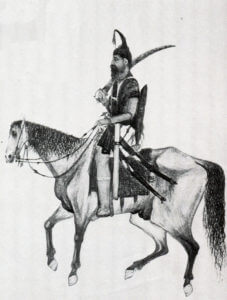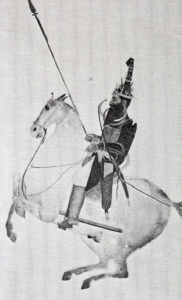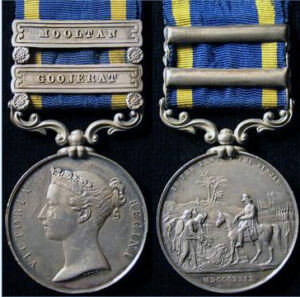The final battle of the Sikh Wars, fought on 21st February 1849, in which Gough’s Anglo-Indian Army of the Punjab methodically destroyed the last Sikh army
The previous battle in the Second Sikh War is the Battle of Chillianwallah
The next battle in the British Battles sequence is the Battle of the Alma
Battle: Goojerat
War: Second Sikh War.
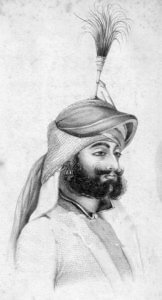
Shere Singh, Sikh commander at the Battle of Goojerat on 21st February 1849 during the Second Sikh War
Date of the Battle of Goojerat: 21st February 1849.
Place of the Battle of Goojerat: In the Punjab in the North-West of India.
Combatants at the Battle of Goojerat: British troops and Indian troops of the Bengal and Bombay Presidencies against Sikhs of the Khalsa, the army of the Punjab, with their Afghan allies.
Commanders at the Battle of Goojerat: Major General Sir Hugh Gough against the Sikh general, Shere Singh.
Size of the armies at the Battle of Goojerat: 24,000 British, Bengal Army and Bombay Army troops with 96 guns, against 60,000 Sikhs with 59 guns.
Uniforms, arms and equipment at the Battle of Goojerat (this section is the same in each of the battles of the Sikh Wars):
The two wars fought between 1845 and 1849 between the British and the Sikhs led to the annexation of the Punjab by the British East India Company, and one of the most successful military co-operations between two races, stretching into a century of strife on the North West Frontier of British India, the Indian Mutiny, Egypt and finally the First and Second World Wars.
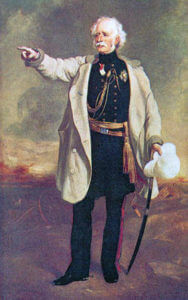
Major General Sir Hugh Gough in his white ‘Battle Coat’: Battle of Goojerat on 21st February 1849 during the Second Sikh War
The British contingent comprised four light cavalry regiments (3rd, 9th, 14th and 16th Light Dragoons- the 9th and 16th being lancers) and twelve regiments of foot (9th, 10th, 24th, 29th, 31st, 32nd, 50th, 53rd, 60th, 61st, 62nd and 80th regiments).
The bulk of General Gough’s ‘Army of the Sutlej’ in the First Sikh War and ‘Army of the Punjab’ in the Second Sikh War comprised regiments from the Bengal Presidency’s army: 9 regular cavalry regiments (the Governor-General’s Bodyguard and 1st, 3rd, 4th, 5th, 6th, 7th, 8th and 11th Bengal Light Cavalry), 13 regiments of irregular cavalry (2nd, 3rd, 4th, 7th to 9th and 11th to the 17th Bengal Irregular Cavalry), 48 regiments of foot (1st to 4th, 7th, 8th, 12th to 16th, 18th, 20th, 22nd, 24th to 27th, 29th to 33rd, 36th, 37th, 41st to 54th, 56th, 59th, 63rd and 68th to 73rd Bengal Native Infantry), horse artillery, field artillery, heavy artillery and sappers and miners.
The Bombay presidency contributed a force that marched in from Scinde, in the west, and gave considerable assistance at the Siege of Multan; the 19th Bombay Native Infantry gaining the title of the Multan Regiment for its services in the siege, a label still held by its Indian Army successor.
A Bombay brigade under Brigadier Dundas joined General Gough’s army for the final battle of the Second Sikh War at Goojerat, where the two regiments of Scinde Horse, Bombay Irregular Cavalry, particularly distinguished themselves. The brigade comprised: 2 regiments of Scinde Horse, 3rd and 19th Bombay Native Infantry and Bombay horse artillery and field artillery.
Each of the three presidencies, in addition to their native regiments, possessed European infantry, of which the 1st Bengal (European) Infantry, 2nd Bengal (European) Light Infantry and 1st Bombay (European) Fusiliers took part in the Sikh Wars.
Other corps fought under the British flag, such as the Shekawati cavalry and infantry and the first two Gurkha regiments: the Nasiri Battalion (later 1st Gurkhas) and the Sirmoor Battalion (later 2nd Gurkhas).
General Gough commanded the British/Indian army at six of the seven major battles (not the Battle of Aliwal). An Irishman, Gough was immensely popular with his soldiers, for whose welfare he was constantly solicitous. The troops admired Gough’s bravery, in action wearing a conspicuous white coat, which he called his ‘Battle Coat’, so that he might draw fire away from his soldiers.
Gough’s tactics were heavily criticised, even in the Indian press in letters written by his own officers. At the Battles of Moodkee, Sobraon and Chillianwallah, Gough launched headlong attacks, considered to be ill-thought out by many of his contemporaries. Casualties were high and excited concern in Britain and India. By contrast, Gough’s final battle, Goojerat, which decisively won the war, cost few of his soldiers their lives and was considered a model of care and planning.
Every battle saw vigorous cavalry actions, with HM 3rd King’s Own Light Dragoons and HM 16th Queen’s Lancers particularly distinguishing themselves. The British light cavalry wore embroidered dark blue jackets and dark blue overall trousers, except the 16th who bore the sobriquet ‘the Scarlet Lancers’ for their red jackets. The headgear of the two regiments of light dragoons was a shako with a white cover; the headgear of the lancers the traditional Polish tschapka.
HM regiments of foot wore red coats and blue trousers with shakos and white covers.
The Bengal and Bombay light cavalry regiments wore pale blue uniforms. The infantry of the presidency armies wore red coats and peak less black shakos.
The weapons for the cavalry were the lance for the lancer regiments and sword and carbine for all; the infantry was armed with the Brown Bess musket and bayonet.
Commands in the field were given by the cavalry trumpet and the infantry drum and bugle.
In the initial battles, the Sikh artillery outgunned Gough’s batteries. Even in these battles and in the later ones, the Bengal and Bombay horse and field artillery were handled with great resource and were a major cause of Gough’s success.
Many of the more senior British officers had cut their military teeth in the Peninsular War, and at the Battle of Waterloo: Gough, Hardinge, Havelock of the 14th Light Dragoons, Cureton, Dick, Thackwell and others. Many of the younger men would go on to fight in the Crimea and the Indian Mutiny.
The Sikhs of the Punjab looked to the sequence of Gurus for their spiritual inspiration, and had established their independence, fiercely resisting the Moghul Kings in Delhi and the Muslims of Afghanistan. The Sikhs were required by their religion to wear the ‘five Ks’, not to cut their hair or beard and to wear the highly characteristic turban, a length of cloth in which the hair is wrapped around the head.
The Maharajah of the Punjab, Ranjit Singh, whose death in 1839 ended the Sikh embargo on war with the British, established and built up the powerful Sikh Army, the ‘Khalsa’, over the twenty years of his reign. The core of the ‘Khalsa’ was its body of infantry regiments, equipped and trained as European troops, wearing red jackets and blue trousers. The Sikh artillery was held in high esteem by both sides. The weakness in the Sikh army was its horse. The regular cavalry regiments never reached a standard comparable to the Sikh foot, while the main element of the mounted arm comprised clouds of irregular and ill-disciplined ‘Gorcharras’.
The traditional weapon of the Sikh warrior is the ‘Kirpan’, a curved sword kept razor sharp and one of the ‘five Ks’ a baptised Sikh must wear. In battle, at the first opportunity, many of the Sikh foot abandoned their muskets and, joining their mounted comrades, engaged in hand to hand combat with sword and shield. Horrific cutting wounds, severing limbs and heads, were a feature of the Sikh Wars, in which neither side gave quarter to the enemy.
It had taken the towering personality of Ranjit Singh to control the turbulent ‘Khalsa’, he had established. Ranjit Singh’s descendants found the task beyond them and did much to provoke the outbreak of the First Sikh War, in the hope that the Khalsa would be cut down to size by the armies of the British East India Company. The commanders of the Sikh armies in the field rarely took the initiative in battle, preferring to occupy a fortified position and wait for the British and Bengalis to attack. In the opening stages of the war there was correspondence between Lal Singh and the British officer, Major Nicholson, suggesting that the Sikhs were being betrayed by their commander.
Pay in the Khalsa was good, twice the rate for sepoys in the Bengal Army, but it was haphazard, particularly after the death of Ranjit Singh. Khalsa administration was conducted by clerks writing in the Persian language. In one notorious mutiny over pay, Sikh soldiers ran riot looking for anyone who could, or looked as if they could, speak Persian, and putting them to the sword.
The seven battles of the war and the siege of the city of Multan were hard fought. Several of the battle fields were wide flat spaces broken by jungly scrub, from which the movement of large bodies of troops in scorching heat raised choking clouds of dust. As the fighting began, the dust clouds intermingled with dense volumes of musket and cannon smoke. With the thunder of gunfire and horses’ hooves, the battle yells and cries of the injured, the battles of the Sikh Wars were indeed infernos.
Winner of the Battle of Goojerat: This convincing victory by Gough’s army ended the Sikh Wars and led to the annexation of the Punjab into British India.
British and Indian Regiments at the Battle of Goojerat:
British Regiments:
HM 3rd King’s Own Light Dragoons, now the Queen’s Royal Hussars. *
HM 9th Queen’s Royal Light Dragoons (Lancers), now the 9th/12th Royal Lancers. *
HM 14th the King’s Light Dragoons, now the King’s Royal Hussars. *
HM 16th Queen’s Light Dragoons (Lancers), now the Queen’s Royal Lancers. *
HM 10th Foot, later the Royal Lincolnshire Regiment and now the Royal Anglian Regiment. *
HM 24th Foot, later the South Wales Borderers and now the Royal Welsh Regiment. *
HM 29th Foot, later the Worcestershire Regiment and now the Worcestershire and Sherwood Foresters Regiment. *
HM 32nd Foot, later the Duke of Cornwall’s Light Infantry and now the Rifles. *
HM 1st Battalion, 60th Rifles, later Royal Green Jackets and now the Rifles. *
HM 61st Foot, later the Wiltshire Regiment and now the Royal Gloucestershire, Berkshire and Wiltshire Regiment. *
Bengal Army regiments:
Cavalry:
1st Bengal Light Cavalry. *
5th Bengal Light Cavalry. *
6th Bengal Light Cavalry. *
8th Bengal Light Cavalry. *
3rd Bengal Irregular Cavalry. *
9th Bengal Irregular Cavalry. *
11th Bengal Irregular Cavalry. *
14th Bengal Irregular Cavalry. *
Infantry:
2nd Bengal (European) Fusiliers. *
8th Bengal Native Infantry. *
15th Bengal Native Infantry. *
20th Bengal Native Infantry. *
25th Bengal Native Infantry. *
30th Bengal Native Infantry. *
31st Bengal Native Infantry. *
36th Bengal Native Infantry. *
45th Bengal Native Infantry. *
46th Bengal Native Infantry. *
51st Bengal Native Infantry. *
52nd Bengal Native Infantry. *
56th Bengal Native Infantry. *
69th Bengal Native Infantry. *
70th Bengal Native Infantry. *
72nd Bengal Native Infantry. *
Horse Artillery and Field Artillery.
Bombay Army regiments:
Cavalry:
1st Scinde Irregular Horse. *
2nd Scinde Irregular Horse. *
Infantry:
1st Bombay (European) Fusiliers.*
3rd Bombay Native Infantry.*
19th Bombay Native Infantry.*
Field Artillery.
Punjab Regiment:
Corps of Guides.*
Cavalry:
1st Scinde Irregular Horse in 1861 became the 5th Bombay Cavalry, from 1903 35th Scinde Horse, from 1922 the 14th Prince of Wales’s Own Scinde Horse and from 1950 the 14th Scinde Horse of the Indian Army.*
2nd Scinde Irregular Horse in 1861 became the 6th Bombay Cavalry, from 1903 36th Jacob’s Horse, from 1922 the 14th Prince of Wales’s Own Scinde Horse and from 1950 the 14th Scinde Horse of the Indian Army.*
The Corps of Guides in 1874 became the Queen’s Own Corps of Guides, in 1922 10th Queen Victoria’s Own Corps of Guides Cavalry (FF), in 1927 The Guides Cavalry (10th) (Queen Victoria’s Own FF) and in 1947 the Guides Cavalry of the Pakistan Army.*
All the Bengal cavalry regiments that fought at Goojerat ceased to exist in 1857.

Army of the Sutlej on the march: Battle of Goojerat on 21st February 1849 during the Second Sikh War
Infantry:
2nd Bengal (European) Light Infantry, in 1861 became 102nd Light Infantry and from 1880 the Royal Munster Fusiliers. Disbanded in 1922.*
31st Bengal Native Infantry in1861 became the 2nd Bengal Light Infantry, in 1903 2nd (Queen’s Own) Rajput Light Infantry, in 1922 1st (Queen Victoria’s Own) Light Infantry Battalion 7th Rajput Regiment and in 1950 became 4th Battalion the Brigade of the Guards of the Indian Army.*
70th Bengal Native Infantry in 1861 became the 11th Bengal Native Infantry and from 1903 11th Rajputs, from 1922 5th Battalion 7th Rajput Regiment; from 1947 5th Battalion, the Rajput Regiment of the Indian Army.*
1st Bombay (European) Fusiliers in 1862 became HM 103rd (Royal Bombay Fusiliers) and from 1880 2nd Battalion Royal Dublin Fusiliers. Disbanded in 1922.*
3rd Bombay Native Infantry in 1903 became the 103rd Mahratta Light Infantry and from 1922 1st Battalion 5th Mahratta Light Infantry; from 1947 1st Battalion, the Mahratta Light Infantry of the Indian Army.*
19th Bombay Native Infantry in 1903 became the 119th Infantry (The Mooltan Regiment) and from 1922 2nd Battalion (Mooltan Battalion) 9th Jat Regiment; from 1947 2nd Battalion (Mooltan Battalion), the Jat Regiment of the Indian Army.*
The remaining Bengal infantry regiments that fought at Goojerat ceased to exist in 1857.
Order of Battle of the Army of the Punjab at the Battle of Goojerat:
General Sir Hugh Gough, Commander-in-Chief:
The Cavalry Division: Major General Sir Joseph Thackwell.
1st Brigade: Brigadier Lockwood; HM 14th Light Dragoons, 1st Bengal Light Cavalry, elements of 11th and 18th Bengal Irregular Cavalry.
2nd Brigade: Brigadier Hearsey; 3rd and 9th Bengal Irregular Cavalry.
3rd Brigade: Brigadier White; HM 3rd Light Dragoons, HM 9th Lancers, 8th Bengal Light Cavalry, Scinde Irregular Horse and 2 troops of horse artillery.
The Guides Cavalry.

British 3rd King’s Light Dragoons at the Battle of Goojerat on 21st February 1849 during the Second Sikh War
1st Infantry Division: General Whish.
Lieutenant Colonel Hervey’s Brigade: HM 10th Foot, 8th and 52nd Bengal Native Infantry, 1 company of Pioneers and 1 troop of horse artillery.
Brigadier Markham’s Brigade: HM 32nd Foot, 51st and 72nd Bengal Native Infantry, 2 troops of horse artillery and a light field battery.
Brigadier Hoggan’s Reserve Brigade: 5th and 6th Bengal Light Cavalry, 45th and 69th Bengal Native Infantry and 1 Bombay light field battery.
2nd Infantry Division: General Gilbert.
Brigadier Penny’s Brigade: 2nd Bengal (Europeans) Fusiliers, 31st and 70th Bengal Native Infantry.
Brigadier Mountain’s Brigade: HM 29th Foot, 30th and 56th Bengal Native Infantry.
3rd Infantry Division: Major General Sir Colin Campbell.
Brigadier Carnegy’s Brigade: HM 24th Foot and 25th Bengal Native Infantry.
Brigadier McLeod’s Brigade: HM 61st Foot, 36th and 46th Bengal Native Infantry and 2 light field batteries.
Brigadier Dundas’ Brigade (Bombay Army): HM 60th Rifles, 1st Bombay (European) Fusiliers, 3rd and 19th Bombay Native Infantry and 1 Bombay light field battery. Also, the Scinde Camel Baggage Corps.
Heavy Artillery:
Ten 18 pounders
Eight 8 inch howitzers.
Account of the Battle of Goojerat:
Following the carnage of the Battle of Chillianwallah, General Gough’s Army of the Punjab camped around the village of Chillianwallah, while for three days, rain poured down.
Shere Singh’s Sikh Army lay at the village of Rassool, between Chillianwallah and the River Jhelum.
The weather cleared, but Gough resolved not to attack the Sikhs until General Whish had joined him with his division, following Whish’s capture of the City of Multan. Shere Singh tried to lure Gough into a premature battle, but to no avail.
The army of Chattar Singh joined the Sikhs at Rassool, bringing a force of 1,500 Afghan cavalry commanded by the son of Dost Mohammed, the Amir of Afghanistan who had so humiliatingly defeated the British in the First Afghan War.
On 25th January 1849, shortage of supplies forced Shere Singh to leave Rassool and march east, to the more fertile country around Goojerat, on the Chenab River.
Gough dispatched Lieutenant Hodson with a force of cavalry to Wazirabad, on the far side of the Chenab, to watch for a Sikh incursion across the river.
On 15th February 1849, Gough broke camp and moved towards the Chenab, to meet Whish’s division and put himself in a position to attack the Sikhs.
On Gough’s direction, Whish sent a small force to reinforce Hodson in Wazirabad.
On 16th, 17th and 18th February 1849, Gough approached the Sikh army in Goojerat. On the last day of the march Whish’s division joined the army.
On 19th and 20th February 1849, Dundas’s Bombay brigade and Markham’s Bengal brigade marched in, giving Gough his decisive force for the final battle with the Sikhs; 24,000 troops and 96 guns.
Gough found the Sikh army, numbering 60,000 men, drawn up to the south of Goojerat. The mass of the regular Sikh infantry, with 59 guns, was in line in the two-mile gap between the dry River Dwara on the right and the flowing Katela River on the left. On each flank, the Sikh cavalry continued the line beyond the two river beds, with the Afghan cavalry on the right. The Sikhs had fortified several villages lying in advance of their line.
Behind the Sikh line, the distant Himalayan Mountains gave a dramatic snow tipped backdrop to the forthcoming battle.
Gough planned to launch his main attack along the side of the Dwara nullah, while the 1st and 2nd cavalry brigades pinned the Sikh left flank and centre. His infantry brigades would be formed for the attack: from the right, Hervey’s, Penny’s and Mountain’s brigades, with Markham’s brigade in support. To the left of Hervey’s would be the heavy guns on the bank of the Dawa: on the left bank of the dry nullah; Carnegy’s, McLeod’s and Dundas’s brigades, with Hoggan’s in support. White’s cavalry brigade would cover the left flank.
The British, Bengal and Bombay troops fell in for the battle soon after dawn on 21st February 1849. Gough rode down the line, wearing his white ‘Fighting Coat’, and was cheered vigorously by his men.
On the signal, the Army of the Punjab advanced two miles towards the Sikh positions, halting as the Sikh guns opened fire.
Gough ordered his gun batteries forward, with a covering of skirmishers, and a heavy duel opened between the opposing artilleries, the Bengal and Bombay artillery outnumbering the Sikh guns nearly two to one. The decisive point came when the two Bengal horse artillery reserve batteries took several Sikh guns in enfilade and destroyed them. After two and half hours of bombardment the Sikh fire began to fade.
With the slackening gunfire, the Sikh cavalry on Gough’s right moved forward towards Hearsay’s cavalry division, leading to extensive manoeuvring between the opposing forces.
The main British infantry attack began as Penny’s and Mountain’s brigades, supported by the heavy guns, moved forward towards the centre of the Sikh line and were received with a heavy fire from the surviving guns.
The village of Bara Kalra (Great Kalra) lay in advance of the right of the Sikh centre. A party of Gough’s light troops moved forward to take the apparently empty village, to be met by a storm of shots from the loop holed houses.
Gilbert, the divisional commander, dispatched the 2nd Bengal (European) Fusiliers to attack the Sikh garrison, the regiment pushing through the village in the face of a stubborn resistance. The Sikhs counter-attacked, pushing the 2nd Fusiliers back through Bara Kalra, until they were halted by blasts of grape shot at close range from Fordyce’s troop of Bengal Horse Artillery, which finally cleared the Sikhs from the village.
At the same time, Hervey’s brigade attacked the twin village of Chota Kalra (Little Kalra), HM 10th Foot and 8th BNI leading the advance.
Again, the resistance was fierce and the fire extremely heavy. Sikh cavalry threatened the right flank of the brigade, forcing the third regiment, 52nd BNI, to form to the right. Markham’s brigade came up, and, with the supporting fire of Mackenzie’s and Anderson’s batteries of Bengal Horse Artillery, Hervey’s battalions took Chota Kalra.
On the left bank of the Dawa Nullah, the artillery cleared the row of villages of their Sikh garrisons and Campbells’ three brigades advanced unopposed, enabling the guns to move forward and take the main Sikh line in enfilade across the Dawa, causing numerous casualties and contributing to the general retreat of the Sikh army.
On Gough’s left, the Sikh cavalry moved forward and round his flank, but were halted by the fire of Duncan’s and Huish’s batteries of Bengal Horse Artillery. This was followed by a charge delivered by the Scinde Horse and a squadron of HM 9th Lancers, which drove the Sikh cavalry back.
All along the line, the Sikh formations were collapsing and taking to flight, in striking contrast to their measured withdrawal in all the previous battles of the wars, other than Aliwal.
Thackwell’s cavalry pursued the Sikhs beyond Goojerat for twelve miles towards the River Jhelum, halting only when his artillery horses were exhausted and could go no further. Hearsey, with the right flank cavalry brigade, joined the rest of the Cavalry Division beyond Goojerat and continued the chase until nightfall.
Pickets were placed on the Chenab River fords, permitting the Sikh soldiers to cross and return to their farms provided they surrendered their weapons.
Casualties at the Battle of Goojerat: British and Indian casualties were 96 killed and 750 wounded. The units that suffered most heavily were the 2nd Bengal (European) Fusiliers and the 31st BNI of Penny’s brigade during the attacks on Bara Kalra.
Sikh casualties have been estimated at 2,000 killed, wounded and captured. They lost 56 guns.
Follow-up to the Battle of Goojerat:
General Gilbert, with a force of infantry, cavalry and guns took up the pursuit the next day, marching fifty miles to the north in three days, halting for three days, and then resuming the advance.
On 14th March 1849, Gilbert reached Rawalpindi and received the surrender of Shere Singh and Lal Singh.
On 19th March 1849, Gilbert crossed the Indus River at Attock in pursuit of Dost Mohammed’s Afghan troops, and, on 21st March 1849, Gilbert’s troops marched into Peshawar. The war was over. The Punjab became part of British India and Sikh soldiers began to join the East India Company’s army.
Anecdotes and traditions from the Battle of Goojerat:
- During the Battle of Goojerat, a party of Sikh horse circled round behind the Anglo-Indian lines and attempted to kill or capture General Gough. They were driven off by the general’s escort of 5th Bengal Light Cavalry.
- The Scinde Irregular Horse excited great admiration from onlookers who saw their charge on the left wing, delivered at great speed and in the closest of order. The regiment captured two Sikh standards. During the pursuit after the battle, the Scinde Irregular Horse pursued the Afghan troops to the Khyber Pass.
- Aspects of the Scinde horsemen’s equipment were much admired and emulated by Indian and British cavalry regiments, such as the shoulder chains, designed to deflect sword cuts, which became and are still characteristic features of cavalry full dress.
- At the Battle of Goojerat, General Gough placed all his irregular cavalry regiments in the battle line, leaving two regular Bengal Light Cavalry regiments, the 5th and 6th, to guard the camp.
- The 56th BNI lost its colours during the battle. One was recaptured and returned to the regiment by Sepoy Raganuth Dube of the 70th BNI, now the 5th Battalion of the Rajput Regiment of the Indian Army.
- Following the two Sikh Wars, Major General Sir Hugh Gough became a peer as Viscount Gough.
Medals and decorations:
British and Indian soldiers who took part in the Second Sikh War received the silver medal entitled ‘Punjab Campaign, 1848-9’.
Clasps were issued for the battles (or in the case of Mooltan the siege) which were described as: ‘Mooltan’, ‘Chillianwallah’, and ‘Goojerat’.
Description of the medal:
Obverse. -Crowned head of Queen Victoria. Legend: ‘Victoria Regina.’
Reverse. -The Sikh army laying down its arms before Sir W.R. Gilbert and his troops near Rawal Pindi. Inscription ‘To the Army of the Punjab.’ In exergue ‘MDCCCXLIX.’
Mounting. -Silver scroll bar and swivel.
Ribbon. -Dark blue with two thin yellow stripes, 1 ¼ inch wide.
References for the Battle of Goojerat:
History of the British Army by Fortescue.
History of British Cavalry by the Marquis of Anglesey.
The previous battle in the Second Sikh War is the Battle of Chillianwallah
The next battle in the British Battles sequence is the Battle of the Alma




